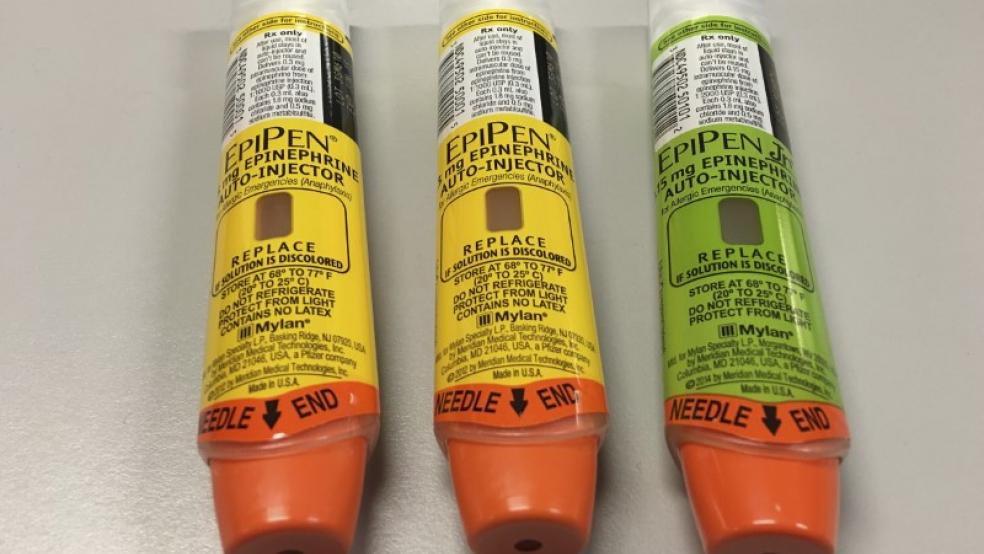NEW YORK (Reuters) - The complex U.S. system for drug pricing creates wide variation in what people pay for the same prescription medications, such as Mylan NV's EpiPen.
A Reuters review of government data found that Mylan's price hikes on the lifesaving allergy shot have increased spending for the U.S. Defense Department, based on its arrangements for covering drug costs.Here's how drug pricing works for different constituencies:How are drug costs covered?Many consumers get drug coverage through employers and have different out-of-pocket expenses based on the terms of those plans. Health insurers or employers pay part of the bill, often receiving rebates off list price negotiated with manufacturers.Among those without insurance, some pay full retail price, while others get coupons from drugmakers that reduce it. Government plans, such as the Medicare program for seniors and Medicaid for the poor, have their own rules. What does Medicaid pay?Drug manufacturers by law must give Medicaid their "best price" and cannot publicly disclose what it is. For brand name drugs with patent protection, manufacturers pay a 23 percent rebate off an average price that reflects all discounts and rebates that commercial buyers get, or rebate the difference between the average price and the lowest or "best price" to any one buyer, excluding the military.Drugmakers also must rebate the cost of any price increase above inflation. For generic drugs, drugmakers pay a rebate of 13 percent off the average manufacturer price, and there is no inflation cap.State Medicaid programs may negotiate supplemental rebates with drugmakers. The rebates and the "best price" benchmarks are confidential by law.How much did Medicaid pay for EpiPen?The Centers for Medicaid and Medicare Services said recently that Medicaid spent $797 million from 2011 to 2015 on EpiPens, including a generic drug rebate of 13 percent plus dispensing fees. The program's annual spending on the device rose from $66 million to $365 million in that time, boosted by wider use and a 250 percent increase in EpiPen list prices. These figures do not reflect rebates.EpiPen packages an older generic drug, epinephrine, in a patent protected easy-to-use injector. CMS has said the drug should no longer be considered a generic. Mylan agreed this month to pay $465 million to settle questions over whether it should have paid Medicaid the higher rebate rate for brand name drugs.It is not clear whether the $797 million reflects any supplemental rebates to state Medicaid programs. Since EpiPen has no competitors, most states likely did not receive additional rebates, according to Matt Salo, executive director of the National Association Medicaid Directors.What does the U.S. military pay for drugs?Companies that sell brand name drugs to Medicaid must also sell them to the military, including Department of Defense and the Department of Veterans Affairs, which tend to pay the lowest U.S. prices. Federal law allows the military to get an even better price than Medicaid.The Department of Defense pays those lower prices for drugs dispensed at military treatment facilities and mail order pharmacies. But, if service members, retirees or their families fill prescriptions at retail pharmacies, the department pays retail price.By law, drug manufacturers must refund the difference between the military's negotiated price for brand name drugs paid at military facilities and the retail pharmacy price. Drugs classified as generic, such as EpiPen, are not eligible for that rebate. What has the military spent on EpiPen? The Defense Department spent a total of $57 million in fiscal 2016, which ended Sept 30. It spent $25.9 million at military treatment facilities, $3.3 million on mail order prescriptions and $27.9 million on prescriptions filled through the Tricare retail pharmacy network. The average price for a pack of two EpiPens at a military treatment facility in fiscal 2016 was $169. At retail outlets, it paid on average $509 for EpiPen and $528 for EpiPen Jr.What does Veterans Affairs pay for EpiPen?The VA is allowed to negotiate additional rebates off the military's discounted price, which is now $183 for a two-pack.The VA spent $11 million on EpiPens in 2015, $11.7 million in 2014, $10.3 million in 2013 and $6.8 million in 2012. The agency declined to detail the number of prescriptions filled or its final price per unit. But it said both rose during the period. (Additional reporting by Ruthy Munoz in Washington; Editing by Michele Gershberg and Lisa Girion)Mylan EpiPen: One piece of a complicated U.S. pricing system

© Jim Bourg / Reuters



